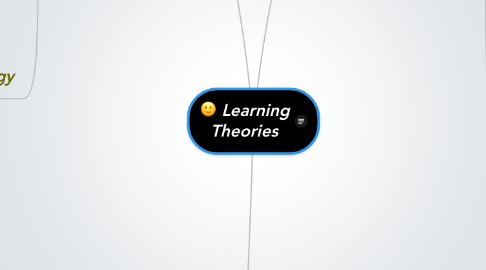
1. Cognitivism
1.1. Representatives
1.1.1. Jean Piaget(1896-1980)
1.1.2. Herbert A. Simon(1916-2001)
1.2. Main iedas
1.2.1. brain-based
1.2.2. patterns rather than isolated events
1.2.3. Two key assumptions
1.2.3.1. the memory system is an active organized IP
1.2.3.2. prior knowledge plays an important role in learning
1.3. Role play
1.3.1. Teacher's role
1.3.1.1. information dispenser, transmitter
1.3.2. Student's role
1.3.2.1. information receiver, processor
1.4. with technology
1.4.1. specific principles
1.4.1.1. interactive assignment, problem-solving, levels of develop, etc.
2. Constructivism
2.1. representatives
2.1.1. Jean Piaget(1896-1980)
2.1.2. Von Glasersfeld(1917-2010)
2.2. Main ideas
2.2.1. Gale (1995): six version of constructivism
2.2.1.1. 1.Social constructivism 2.Social constructionism 3. Radical constructivism 4.Information-processing constructivism 5.Cybernetic systems 6.Social cultural approach
2.2.2. active involvement
2.2.2.1. learner actively constructs
2.2.3. top-down processing
2.2.3.1. personal endeavor
2.2.3.2. current and past knowledge
2.3. Role play
2.3.1. Teacher's role
2.3.1.1. Guide, facilitator
2.3.2. Studnet's role
2.3.2.1. self-directed, sense maker
2.4. with technology
2.4.1. deliver instruction
2.4.2. coaching rather lecture and recitation
2.4.3. more actively engaged
2.4.4. more cooperative and less competitive
2.4.5. integration of visual and verbal thinking
3. Behaviorism
3.1. representatives
3.1.1. B.F. Skinner(1904-1990)
3.1.1.1. in contrast to methodological behaviorism
3.2. Main ideas
3.2.1. Stimulus-response
3.2.2. experimental work
3.2.2.1. Lab animal:rats and pigeons
3.2.2.2. research on trial-and-error
3.2.3. human brain as a black box
3.2.3.1. Mind process are not important
3.2.4. award and punishment
3.2.5. practice makes perfect
3.3. Role play
3.3.1. Students's role
3.3.1.1. passive recipient
3.3.2. Teacher's role
3.3.2.1. dispenser
3.4. with technology
3.4.1. Skinner's case the "technology of teaching"
3.4.1.1. using the devices to make the learning arrangements more effective
